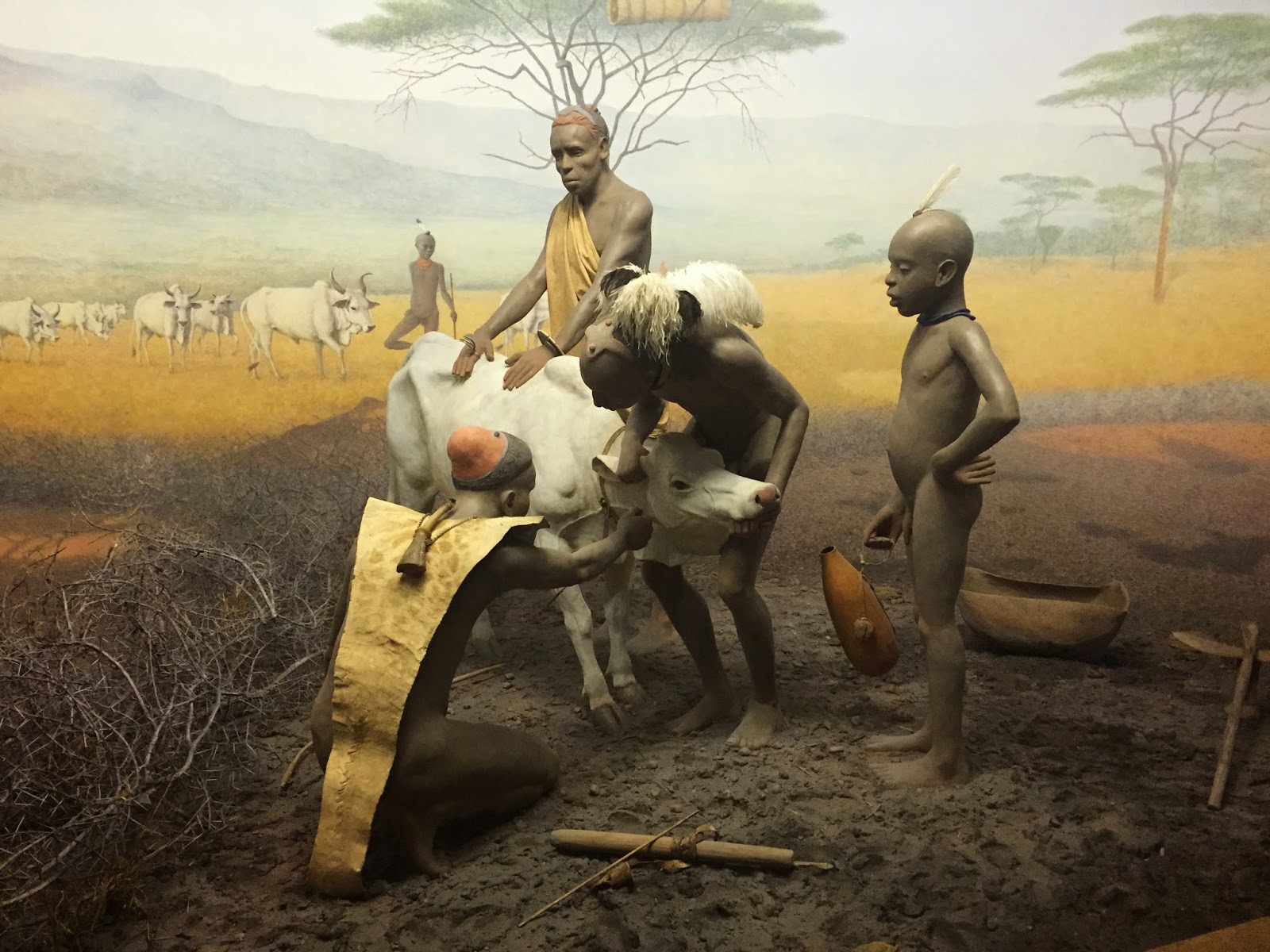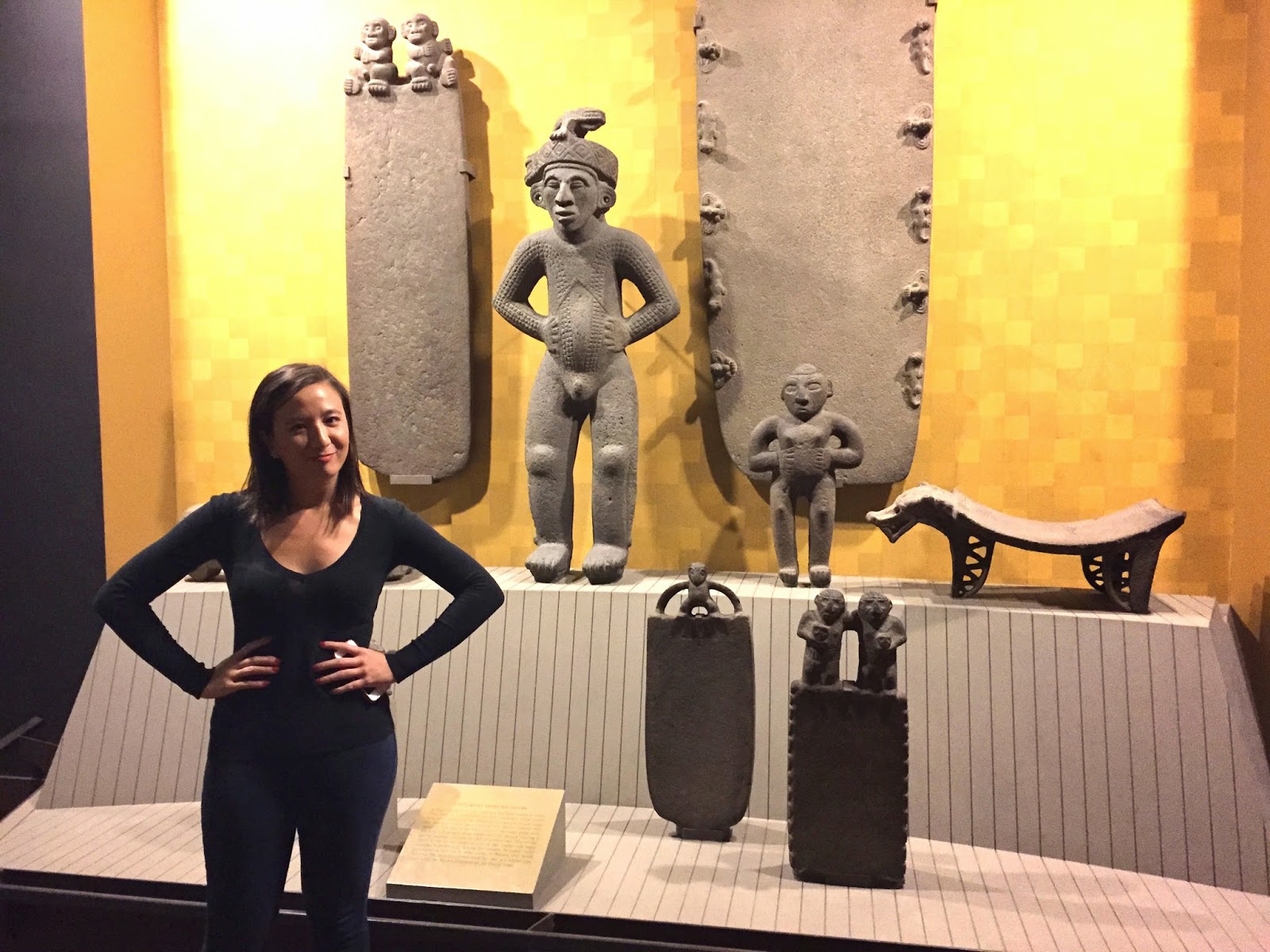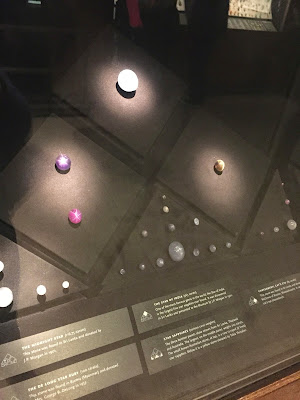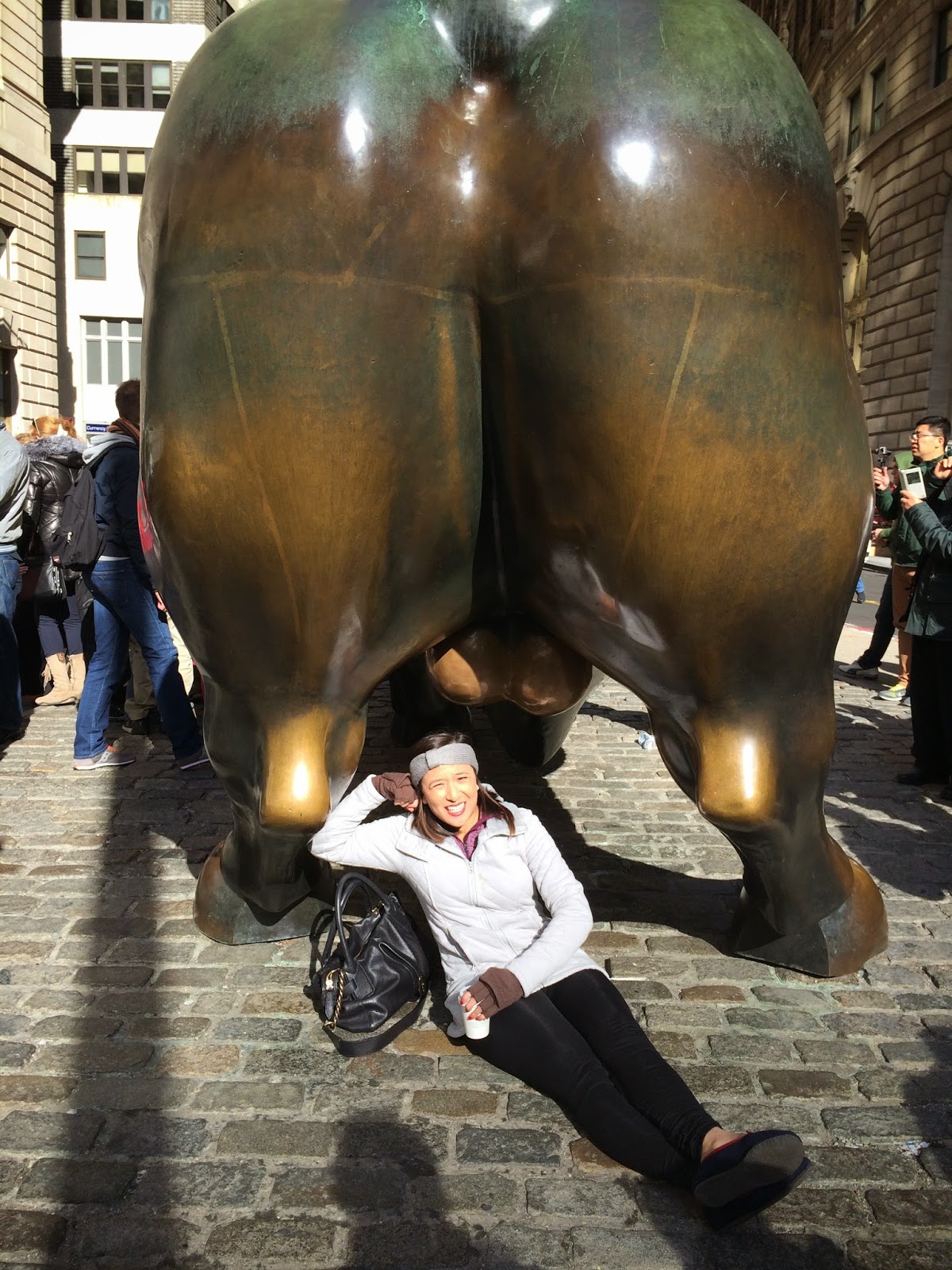After my trip to France, it was nice to be back in the Bay Area and rest for a few weeks. However, a month before my next scheduled CT scan, I started to get anxious. It was time to reevaluate my remaining “healthy time,” and see if I could fit in one more adventure. Since my sister is in graduate school at the University of Florida, my Mom and I don’t get a chance to see her as often. With the craziness of 2014 behind us, we all decided it would be nice to take a Girls Weekend Getaway to New York City.
My first and only trip to New York City was with my family in July 2001, a few months before the September 11th attacks. As a result of this catastrophic event, New York City has always had a special place in my heart.
The WTC Sphere. 2001.
New York City. 2001.
In addition to the rich history, NYC is the leading city for commerce, finance, media, art, and fashion. It happened to be far away from my family too. For all those reasons, when it came time to looking into colleges, the Big Apple was at the top of my list.

Subconsciously, I wanted to discover my true inner self like Felicity.
Ultimately, I didn’t going to school in New York. There were lots of reasons why it “wasn’t for me”, but deep down I know it was because I was afraid of the unknown, and I didn’t think I was strong enough to make it on my own. For the longest time, I’ve lived with the regret of letting my fear of the unknown dictate my life. However, I’ve learned from Andrew that if we made the best decision we could have given what we knew at the time, then we shouldn’t feel regret. In the end, everything worked out for the best because I had an amazing undergraduate experience at UC Santa Barbara, and I made wonderful lifelong friends.
Celebrating Amy's Birthday at Q's. 2007.
Hope you enjoy my West Coast and East Coast Adventure. Cheers!
Over a half-million people attended the three day music festival at San Francisco's Golden Gate Park.
California Academy of Sciences - San Francisco, CA
The Morrison Planetarium has a 75-foot diameter screen and is tilted at a 30 degree angle, making it the largest all-digital dome in the world. I'd highly recommend watching Dark Universe and learning about dark matter and dark energy. Plus, Neil Degrasse Tyson's voice was so soothing.
The living roof is edged by solar panels and its seven hills are lined with 50,000 biodegradable vegetation trays.
White alligators are sensitive to the sun and are an easy target for predators. Most born in the wild would have a low chance of surviving to adulthood.
Instead of hopping, the waxy monkey tree frog grabs branches and moves like a tiny monkey through trees. Secretions coat its skin, giving it a waxy appearance and preventing water loss in its dry environment.
During breeding, the female leafy seadragon deposits eggs onto the male's brood patch. He fertilizes and carries the eggs for about two months, and gives birth to their babies, up to 250 at once.
An electric eel has three pairs of electric organs. One pair produces low voltage pulses for communication and navigation. The other produces a powerful electrical discharge of up to 650 volts for stunning prey.
Skulls Exhibit
Scientists are able to learn about a species' evolution and its life simply by studying their skulls.
New York City
Times Square
Times Square is one of the world's most visited tourist attractions, drawing an estimated 50 million visitors annually.
St. Patrick's Cathedral
The first cornerstone was laid in August 15, 1858, and was formally opened on May 25, 1879.
The stained-glass windows were designed and constructed in England, France, and Germany. It was installed in 1909 with the remainder to follow over the next 25 years.
In honor of its 50th Anniversary, the sanctuary was enlarged, and new chancels and gallery organs were built.
30 Rockefeller Center (GE Building/Comcast Building)
Radio City Music Hall was completed in 1932, and was considered the "largest and most opulent theatre in the world." The Music Hall seats 6,000 people, and has been attended by more than 300 million people.
Rockefeller Center was constructed during the Great Depression’s worst years, gainfully employing over 40,000 people.
The centerpiece of this "city within a city" is 30 Rockefeller Center, an American art deco skyscraper. The elevator had a glass ceiling showing holographic images of old NBC television and sounds.
The escalator brings passengers from the 67th indoor observation area to the 69th floor observation deck.
The 70th floor has a completely open air, unobstructed 360-degree view of the New York Skyline.
At 850 ft. high, the GE building is the 14th tallest in New York City, and the 39th tallest in the United States.
American Museum of Natural History
Hall of Asian Peoples
Gilded Bronze Image of Buddha with Halo of Nagas, Thailand, 19th century
Buddhism believes human beings are caught up in an endless cycle of lives, and that one's form in the next life depends on their behavior in this life.
Mandala of the Two Worlds, 1491 A.D.
Buddhism began in Japan in the 7th century, several centuries after its arrival in China from India and Central Asia.
A Chinese bride from Shantung, China sits in the groom's family bridal chair. The impressive dowery, displayed by the procession on the road, gives prestige to her family as the beauty of the bridal chair gives prestige to the groom's.
Vietnam was occupied by the Chinese for about 1,000 years until A.D. 939. To this day, Chinese culture continues to have a marked influence on Vietnamese life.
Hindu Gate, South India, 17th century.
Hall of African Peoples
Dance is an integral part of African religious life, and reinforces traditional beliefs, and values. Concealing identity is vital since the dancer is transformed into a spiritual being.
Among grassland peoples, herding is closely associated with notions of wealth and prestige, and linked to religious values. A focal point of each day is the drawing a small quantity of blood from the necks of young oxen.
Hall of South American Peoples
The Colossal Olmec Head one of the largest and most impressive of the great stone heads, weighing about 20 tons.
Small ceramic figurines were supposedly household idols, and were found in tremendous numbers in all parts of Teotihuacan.
Come to me, my pretty.
Ceramic Burial Urn, Caimito Style, Peru A.D 1000-1400
People were buried in large human funerary urns, thought to represent chiefs and their deified ancestors.
Music was performed for religious and political ceremonies, entertainment, and recreation. Andean panpipes and trumpets were made in pairs, and often played together.
Indians of Amazonia frequently used the brilliant plumage of tropical birds for their ceremonial costumes.
Why, hello!
Hall of North American Mammals
Grizzly bears are actually the same species as brown bears. The nickname "grizzly" comes from the grizzled, or silver-tipped, hairs on their backs and shoulders.
The mountain goat's muscular forelimbs help brake on downhills and scale inclines as fast as 75 ft. in only a minute.
Hall of Biodiversity
The ocean covers more than two-thirds of the planet, and supports an astonishing array of life.
No pearl in here, just me!
Hall of Ocean Life
The evolution of life on Earth took place in the sea, and this tree of life introduces the evolutionary branches of the major species alive today.
Hall of Northwest Coast Indians
The Great Canoe is the longest still surviving dugout canoe made by the Native people from the Northwest Coast in 1878. These elaborate and painted canoes were usually carved from old growth western red cedar trees.
The first four poles in this hall are from the Kwakwaka'wakw nation of British Columbia. These house posts supported the roof beams of great houses.
Some Kwakiutl masks are two in one. When closed, the mask portrays a particular spirit. When the dancer pulls on the strings, the side panels open to reveal the image of a different spirit.
Hall of Human Origins
Some 3.5 million years ago, two ancient hominids walked across an open plain in eastern Africa. A nearby volcano had recently erupted, and rain had fallen giving the ash the consistency of wet cement, causing their footprint tracks to be fossilized.
Hall of Minerals & Gems
A fluorescent substance exposed to short or long wave UV radiation emits visible light, appearing to glow. This effect results from absorption of radiation followed by emission of lower-energy radiation.
The Star of India (563 carats) is one of the most famous gems in the world. It was discovered in Sri Lanka, and is the largest fine star sapphire ever found.
Dinosaur Fossil Collection
The American Museum of Natural History has one of the greatest dinosaur fossil collections in the world.
The Tyrannosaurus rex is one of the few real specimens on public display. Most museums exhibit cast fossils due to the expense and difficulty of preparing actual fossils.
Scientists debate whether the Stegosaurus' front legs splayed out to the side or were held up straight up and down when the animal walked.
Lonesome George, The Face of Extinction
Lonesome George was the last survivor of the Pinta Island tortoise from Ecuador's Galapagos Island.
When he died of natural causes on June 24, 2012, his species, Chelonoidis abingdoni, became extinct.
One World Trade Center
The 104-story One World Trade Center stands at a symbolic height of 1,776 ft. making it the tallest skyscraper in the Western Hemisphere, and the 4th tallest in the world.
The tower has a bomb resistant 20-story base set on 70-ton shafts of steel and pilings sunk 200 ft. into the earth. Its edges are chamfered back to form 8 isosceles triangles, and is clad in 13,000 pieces of prismatic glass panels.
North Pool
The Memorial's Twin reflecting pools are tribute of remembrance and honor to the nearly 3,000 people killed in the terror attacks of September 11, 2001 and the World Trade Center bombing in February 1993.
The names of every person who died in these attacks are inscribed into bronze panels edging the Memorial pools. This is the largest loss of life resulting from a foreign attack on American soil and the greatest single loss of rescue personnel in American history.
South Pool
The pools sit within the footprints where the Twin Towers once stood. Each is nearly an acre in size, and both are the largest manmade waterfalls in North America.
Trinity Church
The Trinity Church has been part of New York City since 1697. It was established during the British occupation of New York and recognized was the first Anglican Church in Manhattan.
Who doesn't love Gothic Revival architecture?
The Charging Bull
The Charging Bull is a symbol of the strength and power of the American people after the Wall Street Crash of 1987. The 7,100 pound sculpture stands 11 ft. tall and measures 16 ft. long.
This guerilla art was installed by Arturo Di Modica on December 15, 1989. Apparently it's considered good luck to rub the nose, horns and testicles of the bull.
The Metropolitan Museum of Art
European Sculpture and Decorative Arts
Antonio Canova, Perseus with the Head of Medusa, 1804-6, Marble.
This sculpture is a direct rivalry with the ancient marble Apollo Belvedere in the Vatican Museum.
This looks awfully familiar to the one in Paris.
Antoine-Émile Bourdelle, Herakles the Archer, 1909, Gilt bronze.
Fabergé from the Matilda Geddings Gray Foundation Collection
Czar Alexander III presented The Imperial Caucasus Egg to his wife, Maria Feodorovna, on Easter 1893. The egg is adorned with diamonds, pearls, crystal, and ivory.
European Paintings
Claude Monet, Water Lilies, 1916–19, Oil on canvas.
Monet's attempted to capture every observation, impression, and reflection of the lilies and water from the pond that he had dug and planted himself.
Claude Monet, Garden at Sainte-Adresse, 1867, Oil on canvas.
Monet spent the summer of 1867 with his family at Sainte-Adresse, a seaside resort near Le Havre. His father is shown seated in a panama hat.
Vincent van Gogh. Self-Portrait with a Straw Hat, 1887, Oil on canvas.
Selfie with Van Gogh!
Edgar Degas, The Little Fourteen-Year-Old Dancer, 1880, Bronze.
Degas' sculpture was of Marie van Goethem, a ballet student in the Paris Opera.
Modern and Contemporary Art
Jackson Pollock. Autumn Rhythm (Number 30), 1950, Enamel on canvas.
In 1945, Pollock and his wife moved to a modest house near East Hampton, New York. Working in relative isolation in their small barn, Pollock began to develop his distinctive dripped technique.
Mark Rothko, No. 3, 1953, Oil on canvas.
Rothko used canvases roughly the height and width of a human standing with outstretched arms, creating what he called "doors" and "windows" in luminous color.
Andy Warhol, Before and After I, 1961, Casein on canvas.
Warhol based this composition on a small advertisement for a plastic surgeon that ran in the National Enquirer in April 1961, which he had enlarged and projected in order to trace it onto the surface of the canvas. This piece was a precursor to the silk-screen technique he pioneered the following year.
Salvador Dali, Crucifixion (Corpus Hypercubus), 1954, Oil on canvas.
Dali utilized a fusion of Catholicism, mathematics, and science, to create an interpretation of Christ's crucifixion where Christ's body is healthy, athletic, and bears no signs of torture; the crown of thorns and nails are missing.
European Sculpture and Decorative Arts
Choir Screen from the Cathedral of Valladolid, 1763, Iron, set in limestone base.
This wrought-iron screen was once installed in the central nave of the Cathedral of Valladolid in Spain. Screens of this kind were used to close the choir to the public.
Armor of Henry II of France, 1555, Steel, embossed, blued, silvered, and gilt.
This is one of the most elaborate and complete French parade armors, and it retains much of its original coloring. The surfaces are covered by dense foliate scrolls inhabited by human figures and a variety of creatures.
Saber with Scabbard, Turkish, Ottoman period, 19th century, Steel, gold, gilt brass, diamonds, emeralds, pearls.
The most important ceremony in the inauguration of many Islamic rulers was the investiture with a sword, rather than a crown.
Wolfgang Grosschedel, Armor for Man and Horse, 1517-62, Etched steel, leather, copper alloy, textile.
Grosschedel was the most famous armorer in Landshut (Bavaria, Germany). Included among his patrons were the Holy Roman Emperor and Philip II of Spain.
Field Armor of King Henry VIII of England, 1544, Steel, blackened, etched, and gilt.
This armor was made for Henry VIII towards the end of his life, when he was overweight and crippled with gout. It was probably worn during his last military campaign, the siege of Boulogne in 1544.
Saxophones were prominent in early 20th century American music making. They were a staple of community and factory bands, minstrel shows, church ensembles, and vaudeville theatre.
Asian Art
Amida Nyorai (Amitabha), Kamakura period (1185-1333), Wood with gold leaf.
The Buddha Amida sits on a lotus pedestal with his hand joined in the mandra of contemplation. He is considered the Lord of the Pure Land, and promises salvation through faith. His benevolent gaze symbolizes his boundless compassion for mankind.
Buddha of Medicine Bhaishajyaguru (Yaoshi fo), Yuan dynasty (1271–1368), Water-based pigment over foundation of clay mixed with straw.
Kohei Nawa, PixCell-Deer#24, 2011, Taxidermied deer with artificial crystal glass.
This taxidermied deer has been completely transformed through the artist's use of variably sized "PixCell" beads. For Japanese artists, the deer was depicted often as a companion of ancient sages and had auspicious or poetic associations.
Treasures from India: Jewels from the Al-Thani Collection
Jewels of Maharaja Ranjitsinhji Vibhaji of Nawanagar, 1907-33.
The closest I'll ever get to being a Maharaja.
Base of a water pipe (huqqa), North India, 1740-80, Jade inlade with gold wire, diamond, rubies, and emeralds.
The custom of smoking tobacco was introduced by Europeans and became popular at the Mughal and Deccani courts by the late 16th century. By the 18th century, smoking a huqqa was a popular custom at court.
Death Becomes Her, A Century of Mourning Attire
A woman in full mourning dress became the emblematic icon of bereavement in Europe and America during the 19th century. At a time when mortality rates were high, and the average life expectancy was less than 50, the loss of a loved one was a familiar experience.
Mourning dress served as a visual symbol of grief and of respect for the deceased while simultaneously demontrating the wearer's status, taste, and level of priority.
As an individual emerged from mourning, she was allowed details of white, and later garments of gray or mauve.
Other aspects of fashionable attire, such as luster and ornament, precluded during the deepest period of mourning, were gradually reintroduced to the wardrobe.
The Lion King made its Broadway debut on November 13, 1997. With over 6,700 performances, it's the 4th longest Broadway show in history.
Castle Clinton National Monument
Castle Clinton was built in 1811 as one of five forts erected to fend New York Harbor during the War of 1812. The D-shaped fort held 28 cannons, but never saw military action.
Statue Of Liberty National Monument
The Statue of Liberty was a gift of friendship from the people of France to the United States, and is recognized as a universal symbol of freedom and democracy. The Statue of Liberty was designed by Frédéric Auguste Bartholdi, and dedicated on October 28, 1886.
Due to its popularity, access to the Crown and Pedestal are limited, so make sure you have advanced reservations.
Despite many attempts, the original torch failed as a lighthouse, and the holes allowed water to enter the statue, causing rust and damage. As a result, the original torch was removed and replaced with a copper flame covered in 24K gold.
It was really neat to see and touch a full scale replica of the Statue of Liberty's face. The face was said to be modeled after the sculptor's mother, Charlotte.
During the Fabrication Technique, the clay study model was enlarged, wooden forms were built, and sheets of copper were hammered and reinforced with iron bars.
The Statue's pedestal was designed by the American architect Richard Morris Hunt. It took two years of work, and numerous rejected proposals before the final version in 1884. The pedestal is 53 ft. high, 91 sq. ft. at the base, and 65 sq. ft. at the top.
The Statue has spawned generations of souvenirs, pictures, postcards, and keepsakes of every imaginable variety.
Be careful, the fall from the Pedestal to the Ground is 154 ft.
When the statue was originally assembled, it was a dull brown color, reflecting the natural color of its copper plates. Over time, it slowly turned to blue-green color due to the copper oxidizing.
The Statue of Liberty faces southeast, making it a welcoming symbol for arriving ships.
Ellis Island Immigration Museum
From 1892 to 1924, Ellis Island was America's largest and most active immigration station, where over 12 million immigrants were processed.
For the vast majority of immigrants, Ellis Island became an "Island of Hope" and place of unlimited opportunity.
The Emergency Quota Act, passed in 1921, ended U.S's open door immigration policy and significantly reduced the number of admissions by setting quotas according to nationality.
The immigration station officially closed in November 1954.
The Great Hall was where immigrants were once processed. Some immigrants completed the process in a few hours, while others were detained for days or even weeks at a time.
Empire State Building
The Empire State Building is located in the center of Midtown Manhattan. It stands a total of 1,454 ft. making it the 25th tallest building in the world.
The Lobby has beautiful art deco inspired ceiling murals and images. Unfortunately, there was no Buddy the Elf.
The Dare to Dream exhibit showcases the building’s history, engineering and construction through photographs, architectural sketches, construction notes, and bookkeeping documents.
The Empire State Building has graced the skyline in thousands of movies and television shows, most notable the 1933 film King Kong.






















































































































































No comments:
Post a Comment